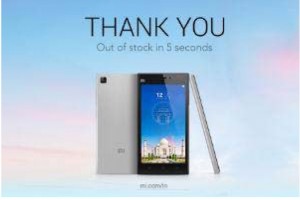Brands crying wolf (stock out) once too many times can hurt their own brand reputation and that of their retailers’!
A Times of India article on July 29, 2014, reporting on the launch of the Mi 3 smartphone by Xiaomi, the Chinese smartphone manufacturer, said that “Xiaomi has claimed that its Mi 3 smartphone went out of stock in just 5 seconds, … when it was put up on sale on Flipkart today. Last week, it had taken 39 minutes for the stock to finish when Mi 3 was first put on sale by the company…Xiaomi has, like last time, not revealed exactly how many units were up for sale in this round.”

Many companies deliberately engineer stock outs to create demand as a stock out can be interpreted as a stock out can be a signal of huge demand. However, there is a fine line in managing this and repeatedly using such an approach comes across as gimmicky, fake, and an annoyance for the consumer, creating a negative consumer sentiment.
Consider this, in the first round of sales on July 25th, 100,000 people registered on Flipkart, the Indian online retailer, for the Mi3 smartphone. With two rounds completed, not all of the 100,000 people who originally registered have yet been able to acquire an Mi3 handset and, according to the Times of India, Xiaomi has “allowed more people to register for the device.” This has made matters even more aggravating for those who are waiting in line.
To rub salt on the proverbial wound, Xiaomi has now announced: “Note that users who have previously registered will have to register again for a chance to purchase” for the next “flash sale” that is scheduled for August 5, 2014.

Not surprisingly, consumers in India are unhappy. Some consumers have tweeted, expressing dissatisfaction about the difficulty of registering in the first place! One irate consumer, a tech blogger with 11,800 followers (twitter handle @Rajupp) has uploaded a video of his negative experience on YouTube, tweeting the link! Others have tweeted their frustration!



Xiaomi appears very happy with the results: Manu Jain, India Operations Head, Xiaomi, said, “We are pleasantly surprised and delighted with the overwhelming response we have received from our India fans.”
I am, however, not so sure that Xiaomi will be happy in the long run. As I said earlier, there is a fine line between signaling you have a hot product, and annoying consumers through what blatantly appears to be a deliberate ploy. The negative reactions are mounting, and my take is that this is likely to damage the brand reputation of Xiaomi in the Indian marketplace. It is also likely to damage the reputation of Flipkart, since anger is likely to spillover on to the retail partner, and it has in this case!


